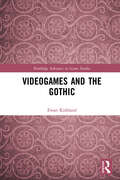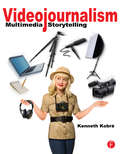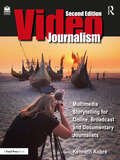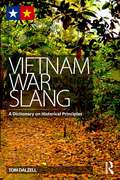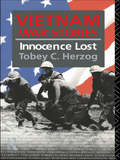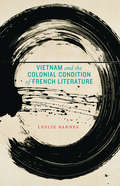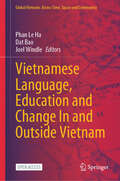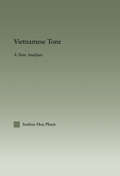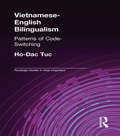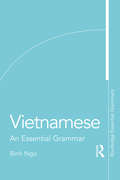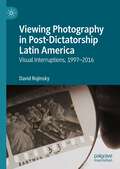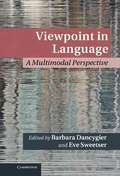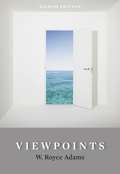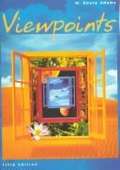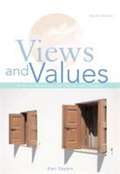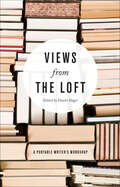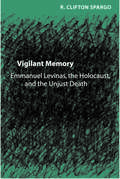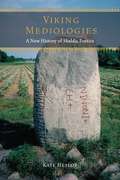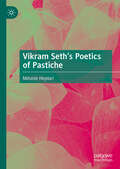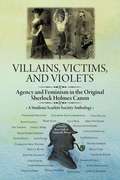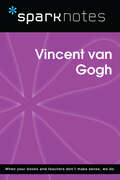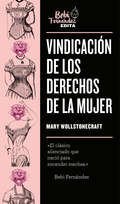- Table View
- List View
Videogames and the Gothic (Routledge Advances in Game Studies)
by Ewan KirklandThis book explores the many ways Gothic literature and media have informed videogame design. Through a series of detailed case studies, Videogames and the Gothic illustrates the extent to which particular tropes of Gothic culture –neo-medieval aesthetics, secret-filled labyrinthine spaces, the sense of a dark past impacting upon the present – have been appropriated by and transformed within digital games. Moving beyond the study of the generic influences of horror on digital gaming, Ewan Kirkland focuses in on the Gothic, a less visceral mode tending towards the unsettling, the uncertain and the uncanny. He explores the extent to which imagery, storylines and narrative preoccupations taken from Gothic fiction facilitate the affordances and limitations of the videogame medium. A core contention of this book is that videogames have developed as an inherently Gothic form of popular entertainment. Arguing for close proximity between Gothic culture and the videogame medium itself, this book will be a key contribution to both Gothic and digital game scholarship; as such, it will have resonance with scholars and students in both areas, as well as those interested in Gothic novels, media and popular culture, digital games and interactive fiction.
Videojournalism: Multimedia Storytelling
by Kenneth KobreVideojournalism is a new field that has grown out of traditional print photojournalism, slideshows that combine sound and pictures, public radio, documentary filmmaking and the best of television news features. This amalgam of traditions has emerged to serve the Internet's voracious appetite for video stories.Videojournalism is written for the new generation of "backpack" journalists. The solo videojournalist must find a riveting story; gain access to charismatic characters who can tell their own tales; shoot candid clips; expertly interview the players; record clear, clean sound; write a script with pizzazz; and, finally, edit the material into a piece worthy of five minutes of a viewer's attention. Videojournalism addresses all of these challenges, and more - never losing sight of the main point: telling a great story. This book, based on extensive interviews with professionals in the field, is for anyone learning how to master the art and craft of telling real short-form stories with words, sound and pictures for the Web or television. The opening chapters cover the foundations of multimedia storytelling, and the book progresses to the techniques required to shoot professional video, and record high quality sound and market the resulting product. Videojournalism also has its own website - go to just one URL and find all the stories mentioned in the book. You also will find various "how-to" videos on the site. To keep up with the latest changes in the field such as new cameras, new books, new stories or editing software, check the site regularly and "like" www.facebook.com/KobreGuide.
Videojournalism: Multimedia Storytelling for Online, Broadcast and Documentary Journalists
by Kenneth KobreVideojournalism: Multimedia Storytelling for Online, Broadcast and Documentary Journalists is an essential guide for solo video storytellers—from "backpack" videojournalists to short-form documentary makers to do-it-all broadcast reporters.Based on interviews with award-winning professionals sharing their unique experiences and knowledge, Videojournalism covers topics such as crafting and editing eye-catching short stories, recording high-quality sound, and understanding the laws and ethics of filming in public and private places. Other topics include:• understanding the difference between a story and a report• finding a theme and telling a story in a compact time frame• learning to use different cameras and lenses—from smart phones to mirrorless and digital cinema cameras• using light, both natural and artificial • understanding color and exposureThe second edition of this best-selling text has been completely revised and updated. Heavily illustrated with more than 550 photographs, the book also includes more than 200 links to outstanding examples of short-form video stories. Anatomy of a News Story, a short documentary made for the book, follows a day in the life of a solo TV videojournalist on an assignment (with a surprise ending), and helps readers translate theory to practice.This book is for anyone learning how to master the art and craft of telling real, short-form stories with words, sound, and pictures for the Web or television.A supporting companion website links to documentaries and videos, and includes additional recommendations from the field’s most prominent educators.
Vietnam War Slang: A Dictionary on Historical Principles
by Tom DalzellIn 2014, the US marks the 50th anniversary of the Gulf of Tonkin Resolution, the basis for the Johnson administration’s escalation of American military involvement in Southeast Asia and war against North Vietnam. Vietnam War Slang outlines the context behind the slang used by members of the United States Armed Forces during the Vietnam War. Troops facing and inflicting death display a high degree of linguistic creativity. Vietnam was the last American war fought by an army with conscripts, and their involuntary participation in the war added a dimension to the language. War has always been an incubator for slang; it is brutal, and brutality demands a vocabulary to describe what we don’t encounter in peacetime civilian life. Furthermore, such language serves to create an intense bond between comrades in the armed forces, helping them to support the heavy burdens of war. The troops in Vietnam faced the usual demands of war, as well as several that were unique to Vietnam – a murky political basis for the war, widespread corruption in the ruling government, untraditional guerilla warfare, an unpredictable civilian population in Vietnam, and a growing lack of popular support for the war back in the US. For all these reasons, the language of those who fought in Vietnam was a vivid reflection of life in wartime. Vietnam War Slang lays out the definitive record of the lexicon of Americans who fought in the Vietnam War. Assuming no prior knowledge, it presents around 2000 headwords, with each entry divided into sections giving parts of speech, definitions, glosses, the countries of origin, dates of earliest known citations, and citations. It will be an essential resource for Vietnam veterans and their families, students and readers of history, and anyone interested in the principles underpinning the development of slang.
Vietnam War Stories: Innocence Lost
by Tobey C. HerzogThe Gulf War and its aftermath have testified once again to the significance placed on the meanings and images of Vietnam by US media and culture. Almost two decades after the end of hostilities, the Vietnam War remains a dominant moral, political and military touchstone in American cultural consciousness. Vietnam War Stories provides a comprehensi
Vietnam and the Colonial Condition of French Literature
by Leslie BarnesVietnam and the Colonial Condition of French Literature explores an aspect of modern French literature that has been consistently overlooked in literary histories: the relationship between the colonies—their cultures, languages, and people—and formal shifts in French literary production. Starting from the premise that neither cultural identity nor cultural production can be pure or homogenous, Leslie Barnes initiates a new discourse on the French literary canon by examining the work of three iconic French writers with personal connections to Vietnam: André Malraux, Marguerite Duras, and Linda Lê. In a thorough investigation of the authors’ linguistic, metaphysical, and textual experiences of colonialism, Barnes articulates a new way of reading French literature: not as an inward-looking, homogenous, monolingual tradition, but rather as a tradition of intersecting and interdependent peoples, cultures, and experiences. One of the few books to focus on Vietnam’s position within francophone literary scholarship, Barnes challenges traditional concepts of French cultural identity and offers a new perspective on canonicity and the division between “French” and “francophone” literature.
Vietnamese Language, Education and Change In and Outside Vietnam (Global Vietnam: Across Time, Space and Community)
by Dat Bao Phan Le Ha Joel WindleThis open access edited book attempts to break new ground in investigating multiple facets of Vietnamese language, education and change in global contexts, engaging with global Vietnam through complex lenses of language and education. Issues of language, globalization, and global identities have often been framed through the lens of hierarchical/binary power relations, and/or through a dichotomy between hyper-central languages, such as English, and revisualized or marginalized local language and cultures. In this book, this dichotomy is turned on its head by considering how Vietnam and Vietnamese are constructed in and outside Vietnam and enacted in global spaces of classrooms, textbooks, student mobility, community engagement, curriculum, and intercultural contacts. Vietnamese is among the world’s most spoken languages and is ranked in the top 20th in terms the number of speakers. Yet, at the same time, as a ‘peripheral’ or ‘southern’ global language as often seen in the Global North-Global South spectrum, the dynamics of multilingual and multicultural encounters involving Vietnamese generate distinctive dilemmas and tensions, as well as pointing to alternative ways of thinking about global phenomena from a fresh angle. Rather than being outside of the global, Vietnamese - like many other ‘non-central’ global languages - is present in diasporas, commercial, and transnational structures of higher education, schooling, and in the more conventional settings of primary and secondary school, in which visions of culture and language also evoke notions of heritage and tradition as well as bring to the fore deep seated ideological conflicts across time, space, communities, and generations. Relevant to students and scholars researching language, education, identity, multiculturalism, and their intersections, particularly related to Vietnam, but also in Southeast Asia and beyond, this volume is a pioneering investigation into overlooked contexts and languages from a global, southern-oriented perspective."This book presents an eclectic collection of 15 chapters unified by an interest in developing and teaching the Vietnamese language. To my knowledge, there has been no previous attempt to make the national language of Vietnam a focus for as many perspectives as are documented in the book. In this regard, the book makes an original and intriguing contribution to the literature on Vietnamese culture, including the culture of Vietnam’s expanding diaspora. The book is pioneering in the extent to which it draws attention to the many roles played by a national language in a nation’s political, social and cultural development. It also documents the challenges of preserving a national language in settings where it is at risk of being marginalized. It is pleasing that so many of the contributing authors are young Vietnamese scholars who can provide a distinctly Vietnamese perspective on concepts and practices of global significance."- Dr. MartinHayden, Emeritus Professor of Higher Education, Southern Cross University, Australia "Vietnamese Language, Education and Change In and Outside Vietnam brings together an excellent collection of chapters that highlight the diverse and important but under-explored roles Vietnamese language plays in different settings within and outside Vietnam. The fifteen chapters of this much needed book provide unique insights into various aspects and meanings of Vietnamese language. Collectively, the volume contributes to broadening our view about the evolution and transformation of Vietnamese language under the impacts of local, national, regional and global forces. The book invites readers to engage in a reflective and intersectional approach to rethinking and re-examining our understandings of the changes and developments of Vietnamese language over the history of the country."- Dr Ly Tran, Professor, Centre for Research for Educational Impact (REDI), Deakin University, Australia, and Founder: Australia-Vietnam
Vietnamese Tone: A New Analysis (Outstanding Dissertations in Linguistics)
by Andrea Hoa PhamThis new book offers research that will affect further study of tone in Vietnamese and other tonal languages.
Vietnamese-English Bilingualism: Patterns of Code-Switching (Routledge Studies in Asian Linguistics #1)
by Ho-Dac TucThis book is concerned with three central issues: the universality of constraints on code-switching, the nature of the relation between language contact and bilingualism, and the social and linguistic components that facilitate code-switching.
Vietnamese: An Essential Grammar (Routledge Essential Grammars)
by Binh NgoVietnamese: An Essential Grammar is a concise and user-friendly reference guide to modern Vietnamese. It presents a fresh and accessible description of the language in short, readable sections. Features include: Clear and up-to-date examples of modern usage. Special attention to those points which often cause problems to English-speaking learners. Vietnamese / English comparisons and contrasts highlighted throughout. The final section covers pronunciation, providing an introduction to the syllable structure of Vietnamese, and highlighting common errors made by English-speaking learners. Accompanying audio tracks for this chapter are available at www.routledge.com/9781138210707. Vietnamese: An Essential Grammar is ideal for learners involved in independent study and for students in schools, colleges, universities and adult classes of all types.
Viewing Photography in Post-Dictatorship Latin America: Visual Interruptions, 1997-2016
by David RojinskyThis book examines the archival aesthetic of mourning and memory developed by Latin American artists and photographers between 1997-2016. Particular attention is paid to how photographs of the assassinated or disappeared political dissident of the 1970s and 1980s, as found in family albums and in official archives, were not only re-imagined as conduits for private mourning, but also became allegories of social trauma and the struggle against socio-political amnesia. Memorials, art installations, photo-essays, street projections, and documentary films are all considered as media for the reframing of these archival images from the era of the Cold War dictatorships in Argentina, Chile, Guatemala, and Uruguay. While the turn of the millennium was supposedly marked by “the end of history” and, with the advent of digital technologies, by “the end of photography,” these works served to interrupt and hence, belie the dominant narrative on both counts. Indeed, the book's overarching contention is that the viewer’s affective identification with distant suffering when engaging these artworks is equally interrupted: instead, the viewer is invited to apprehend memorial images as emblems of national and international histories of ideological struggle.
Viewpoint in Language
by Barbara Dancygier Eve SweetserWhat makes us talk about viewpoint and perspective in linguistic analyses and in literary texts, as well as in landscape art? Is this shared vocabulary marking real connections between the disparate phenomena? This volume argues that human cognition is not only rooted in the human body, but also inherently 'viewpointed' as a result; consequently, so are language and communication. Dancygier and Sweetser bring together researchers who do not typically meet on common ground: analysts of narrative and literary style, linguists examining the uses of grammatical forms in signed and spoken languages, and analysts of gesture accompanying speech. Using models developed within cognitive linguistics, the book uncovers surprising functional similarities across various communicative forms, arguing for specific cognitive underpinnings of such correlations. What emerges is a new understanding of the role and structure of viewpoint and a groundbreaking methodology for investigating communicative choices across various modalities and discourse contexts.
Viewpoints: Readings Worth Thinking and Writing About
by W. Royce AdamsSpark your interest in writing with VIEWPOINTS. This thematically organized reader offers diverse perspectives on various themes and issues, including social concerns, media, human behavior, cultural differences, and human rights. With opening chapters that include substantial writing and reading instruction and writing assignments both at the end of each reading and on the web, VIEWPOINTS takes writing and critical-thinking skills to the next level. This thoroughly revised Eighth Edition builds on the success of previous editions with twenty-four new readings, six new thought-provoking photographs, author biographies, and source information for every selection.
Viewpoints: Readings Worth Thinking and Writing About (5th edition)
by W. Royce AdamsViewpoints, a thematically organized reader, offers diverse perspectives on various themes and issues, such as work, media, human behavior, and cultural heritage. With opening chapters of substantial writing and reading instruction and with writing assignments both at the end of each reading and on the Web, Viewpoints, is an ideal reader for honing writing and critical-thinking skills. Students love Viewpoints, for its helpful guidance, such as pre-reading techniques; methods on evaluating an essay for content, structure, and point-of-view; and advice on choosing good essay topics. The Sixth Edition now includes new opportunities for collaboration.
Views and Values: Diverse Readings on Universal Themes
by Kari SayersVIEWS AND VALUES is a thematic collection of 27 short fiction and non-fiction selections from international authors. Though the topics of the readings vary, the theme of "The Human Condition" threads through each of the selections to help students make connections in the different styles of writing.
Views from the Loft: A Portable Writer's Workshop
by Edited;Introduced by Daniel Slager“Packed with inspirational, useful, and thought-provoking essays on the craft of writing from some of the best writers around.” —Minneapolis Star TribuneTeachers, exercises, mentors, critiques, humor, and inspiration: these form the fuel all writers need when they get down to work every day. For decades the Loft Literary Center has provided this fuel to an enormous community of writers. Views from the Loft brings together the collected wisdom of that community—its authors, students, and editors—giving anyone the tools and inspiration necessary to thrive in the writing life.A who’s who of writers on writing ranging from the National Book Award–winning poet Mark Doty to Newbery Medal–winning children’s author Kate DiCamillo, and touching on issues as delicate as the representation of family in memoir and as hilarious as a “sad-epiphany poem” mad lib for frustrated poets, this book is an essential collection of crucial tips and challenging questions for everyone who puts pen to page. The essays and interviews in this book include superstar writers like Rick Bass, Michael Cunningham, Grace Paley, Jim Moore, Kathleen Norris, Susan Power, Susan Straight, Bao Phi, Marilyn Hacker, Shannon Olson, R.D. Zimmerman, Lorna Landvik, Vivian Gornick, Yehuda Amichai, and many more.
Vigilant Memory: Emmanuel Levinas, the Holocaust, and the Unjust Death
by R. Clifton SpargoVigilant Memory focuses on the particular role of Emmanuel Levinas's thought in reasserting the ethical parameters for poststructuralist criticism in the aftermath of the Holocaust. More than simply situating Levinas's ethics within the larger context of his philosophy, R. Clifton Spargo offers a new explanation of its significance in relation to history.In critical readings of the limits and also the heretofore untapped possibilities of Levinasian ethics, Spargo explores the impact of the Holocaust on Levinas's various figures of injustice while examining the place of mourning, the bad conscience, the victim, and the stranger/neighbor as they appear in Levinas's work. Ultimately, Spargo ranges beyond Levinas's explicit philosophical or implicit political positions to calculate the necessary function of the "memory of injustice" in our cultural and political discourses on the characteristics of a just society. In this original and magisterial study, Spargo uses Levinas's work to approach our understanding of the suffering and death of others, and in doing so reintroduces an essential ethical element to the reading of literature, culture, and everyday life.
Vigilante Women in Contemporary American Fiction
by Alison Graham-BertoliniGraham-Bertolini provides the first analysis of vigilante women in contemporary American fiction. By developing a dynamic model of vigilante heroines using literary and feminist theory and applying it to important texts, this analysis broadens our understanding of how law and culture infringe upon women's rights.
Viking Mediologies: A New History of Skaldic Poetics (Fordham Series in Medieval Studies)
by Kate HeslopWINNER, ALDO AND JEANNE SCAGLIONE PRIZE FOR STUDIES IN GERMANIC LANGUAGES AND LITERATURESViking Mediologies is a study of pre-modern multimedia rooted in the embodied poetic practice of Viking Age skalds. Prior study of the skaldic tradition has focused on authorship—distinctions of poetic style, historical contexts, and attention to the oeuvres of the skalds whose names are preserved in the written tradition. Kate Heslop reconsiders these not as texts but as pieces in a pre-modern media landscape, focusing on poetry’s medial capacity to embody memory, visuality, and sound.Mobile, hybrid, diasporic social formations—bands of raiders and traders, petty kingdoms, colonial expeditions—achieved new prominence in the Viking Age. Skalds offered the leaders of these groups something uniquely valuable. With their complicated poetry, they claimed to be able to capture shared contingent meanings and re-mediate them in named, memorable, reproducible works. The commemorative poetry in kviðuháttr remembers histories of ruin and loss. Skaldic ekphrasis discloses and reproduces the presence of the gods. Dróttkvætt encomium evokes for the leader’s retinue the soundscape of battle.As writing arrived in Scandinavia in the wake of Christianization, the media landscape shifted. In the poetry of the twelfth and thirteenth centuries, skalds adjusted to the demands of a literate audience, while the historical and poetological texts of the Icelandic High Middle Ages opened a dialogue between Latin Christian ideas of mediation and local traditions. In the Second Grammatical Treatise, for example, the literate technology of the grid is used to analyze the complex resonances of dróttkvætt as the output of a syllable-spewing hurdy-gurdy—a poetry machine.Offering both new readings of both canonical works such as Ynglingatal, Ragnarsdrápa, and Háttatal, and examinations of lesser-known texts like Glymdrápa, Líknarbraut, and Sturla Þórðarson’s Hákonarkviða, Viking Mediologies explores the powers and limits of poetic mediation.
Vikram Seth’s Poetics of Pastiche
by Mélanie HeydariVikram Seth is a critical enigma. He is recognized as one of the most important Indian Anglophone authors of his generation; his individual works have been widely reviewed, yet his work has rarely been approached as a whole and remains surprisingly understudied. Perhaps the chief reason for the paucity of critical response to the full compass of Seth’s work is his disregard for intellectual fashion. Indeed, Seth is at once very popular and deliberately unfashionable. His literary affiliations are conservative; seemingly uninterested in any revisionary narrative, he is equally unconcerned by the interpenetration of cultures in our globalized world, representing assimilation rather than cultural difference. He defies the expectations of both postcolonial and world literature; therefore, to discuss his critical neglect is to shed light on the limitations of these labels. As the most thorough attempt to map a general poetics in Seth’s work, this study – the first of its kind on this writer– develops a new critical methodology to capture the nuances of Seth’s literary strategies. It provides scholars and students insight into the key features of Seth’s work and uncovers a consistent authorial strategy running through his seemingly disconnected body of work, namely a systematic use of intertextual practices.
Villains, Victims, and Violets: Agency and Feminism in the Original Sherlock Holmes Canon (A\studious Scarlets Society Anthology Ser.)
by Tamara (Resa) Bower (Haile)Modern writers have reconsidered every subject under the sun through the lens of Sherlock Holmes. The overlooked subject is agency: the opportunities available to these women for independence and control. What we find all too often are the silences around
Vinayaka Krishna Gokak
by Surendranath MinajagiOn the works of Vinayak Krishna Gokak, b. 1909, Kannada author.
Vincent van Gogh (SparkNotes Biography Guide)
by SparkNotesVincent van Gogh (SparkNotes Biography Guide) Making the reading experience fun! SparkNotes Biography Guides examine the lives of historical luminaries, from Alexander the Great to Virginia Woolf. Each biography guide includes:An examination of the historical context in which the person lived A summary of the person&’s life and achievements A glossary of important terms, people, and events An in-depth look at the key epochs in the person&’s career Study questions and essay topics A review test Suggestions for further reading Whether you&’re a student of history or just a student cramming for a history exam, SparkNotes Biography guides are a reliable, thorough, and readable resource.
Vindicación de los derechos de la mujer
by Mary WollstonecraftLa colección «Bebi Edita» arranca con una de las primeras obras de la literatura y filosofía feministas. El primer manifiesto feminista revisado por una de las voces actuales más revolucionarias: Bebi. Desde su perspectiva única, @SrtaBebi comenta el texto madre del feminismo moderno, Vindicación de los derechos de la mujer, de Mary Wollstonecraft, una relectura con una granada en una mano y un subrayador en la otra. *** @SrtaBebi empezó incendiando las redes con más de 615.000 seguidores. Poco después inflamó libros: Indomable lleva más de 85.000 ejemplares vendidos. Ahora llega para editar su propia colección: «Bebi Edita». Ella decide autores, textos y añade su personal y único punto de vista en un prólogo y comentarios que acompañan a cada libro de la colección. Para seguir quemando.
Vindicación de los derechos de la mujer
by Mary WollstonecraftLa colección «Bebi Edita» arranca con una de las primeras obras de la literatura y filosofía feministas. El primer manifiesto feminista revisado por una de las voces actuales más revolucionarias: Bebi. Desde su perspectiva única, @SrtaBebi comenta el texto madre del feminismo moderno, Vindicación de los derechos de la mujer, de Mary Wollstonecraft, una relectura con una granada en una mano y un subrayador en la otra. *** @SrtaBebi empezó incendiando las redes con más de 615.000 seguidores. Poco después inflamó libros: Indomable lleva más de 85.000 ejemplares vendidos. Ahora llega para editar su propia colección: «Bebi Edita». Ella decide autores, textos y añade su personal y único punto de vista en un prólogo y comentarios que acompañan a cada libro de la colección. Para seguir quemando.
